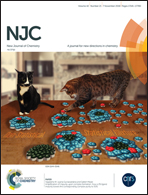α-Diimine homologues of cisplatin: synthesis, speciation in DMSO/water and cytotoxicity†
Abstract
The Pt(II) α-diimine complexes [PtCl2{κ2N-(HCNR)2}] (R = C6H11, 1; 4-C6H10OH, 2; 4-C6H4CH3, 3; 4-C6H4OH, 4) and [PtCl2{κ2N-(CH3CNOH)2}] (5) were prepared in 60–81% yields from the 1 : 1 molar reactions of cis-[PtCl2(DMSO)2] with the appropriate α-diimine, [HCN(R)]2 (R = C6H11, L1; 4-C6H10OH, L2; 4-C6H4Me, L3; 4-C6H4OH, L4), or dimethylglyoxime (dmgH2), in acetone at reflux. The reaction of cis-[PtCl2(DMSO)2] with two molar equivalents of dmgH2 and NEt3 in methanol at reflux afforded the bis-dimethylglyoximato compound [Pt{κ2N,N′-(ON![[double bond, length as m-dash]](https://www.rsc.org/images/entities/char_e001.gif) C(CH3)C(CH3)
C(CH3)C(CH3)![[double bond, length as m-dash]](https://www.rsc.org/images/entities/char_e001.gif) NOH)}2], [Pt(dmgH)2], as an insoluble material, in 97% yield. The oxalato derivative [Pt(κ2O-C2O4){κ2N-(HCN(C6H11))2}], 6, was obtained from the sequential treatment of 1 with AgNO3 and Na2C2O4, in 61% yield. Attempts to functionalize 4via esterification of the hydroxyl groups with aspirin (aspCO2H) led to [PtCl2{κ2N-(HCN(4-C6H4OCO-asp))2}], 7, in an admixture with 4. All the products were characterized by elemental analysis, and IR and multinuclear NMR spectroscopy, and the molecular structures of 4·THF and 5 were elucidated by single crystal X-ray diffraction. NMR spectroscopic studies in DMSO or DMSO/water/NaCl evidenced the substantial stability of 1–2 at 37 °C over 72 hours, whereas 3–5 released their N,N-ligand. The cytotoxic activity of 1, 2 and 6 was assessed on cisplatin sensitive and cisplatin resistant human ovarian carcinomas (A2780 and A2780cisR) and non-tumorigenic human embryonic kidney (HEK-293) cells. Compound 1 is moderately cytotoxic, whereas 2 and 6 did not display appreciable antiproliferative activity.
NOH)}2], [Pt(dmgH)2], as an insoluble material, in 97% yield. The oxalato derivative [Pt(κ2O-C2O4){κ2N-(HCN(C6H11))2}], 6, was obtained from the sequential treatment of 1 with AgNO3 and Na2C2O4, in 61% yield. Attempts to functionalize 4via esterification of the hydroxyl groups with aspirin (aspCO2H) led to [PtCl2{κ2N-(HCN(4-C6H4OCO-asp))2}], 7, in an admixture with 4. All the products were characterized by elemental analysis, and IR and multinuclear NMR spectroscopy, and the molecular structures of 4·THF and 5 were elucidated by single crystal X-ray diffraction. NMR spectroscopic studies in DMSO or DMSO/water/NaCl evidenced the substantial stability of 1–2 at 37 °C over 72 hours, whereas 3–5 released their N,N-ligand. The cytotoxic activity of 1, 2 and 6 was assessed on cisplatin sensitive and cisplatin resistant human ovarian carcinomas (A2780 and A2780cisR) and non-tumorigenic human embryonic kidney (HEK-293) cells. Compound 1 is moderately cytotoxic, whereas 2 and 6 did not display appreciable antiproliferative activity.



 Please wait while we load your content...
Please wait while we load your content...